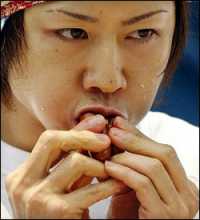Levine, the chief director of gastrointestinal radiology at UP Hospital, studied competitive eaters’ stomachs using fluoroscopy, a real-time x-ray technology, that allowed him to watch their gut as they ate. For the study, Levine recruited a hotdog eating champion (ranked in the top 10 at the time) against a man that was substantially bigger, about 4 inches taller and 45 lbs heavier. Challenging the two to a hotdog eating contest, Levine then watched their stomachs as they ate. What he noticed was a difference in the natural way that our stomachs and digestive systems’ musculature move food through from esophagus to anus.
Called peristalsis, or anal propagation, it’s a wave-like series of muscle contractions that moves the partially digested food through our systems. This means that as food enters one segment of our digestive tract, the previous one has contracted to push the material through. When our stomachs begin digesting, they contract to move some of that material into our large intestine, thereby controlling how much of the actual food can be held within our stomachs at any one time.
What Levine found is that competitive eaters exhibit almost no peristalsis at all. After seven hotdogs the regular hotdog eater felt full and had to stop. The competitive eater, after 10 minutes and 36 hotdogs, was asked to stop. He still did not feel full and so was exhibiting almost no peristalsis. By continually doing this over time, he had trained his stomach to expand to greater and greater lengths, without feeling full and contracting much. In fact, after 36 hotdogs his stomach had expanded to take up most of the space within his upper abdomen.
Just as Michael Phelps was born with the physiology of a natural swimmer, he then honed his body to be exceptional in the water. In the same way, competitive eaters are born with naturally low occurrences of the peristalsis that makes most of us feel full, they then train their stomachs to stretch to abnormal lengths. Make no mistake, however, the toll this takes on their bodies and the level of fitness can be just as taxing as that of an elite swimmer.
